Wildlife
Featured Wildlife Management Programs
Learn about start dates, transferring credits, availability of financial aid, and more by contacting the universities below.
BS in Environmental Science - Natural Resources & Conservation
Develop a broad-based interdisciplinary skill set to solve complex environmental problems like climate change, alternative energy and sustainability with a specialized online degree from Southern New Hampshire University.
Types of Degrees Wildlife Majors Are Getting
The following table lists how many wildlife management graduations there were for each degree level during the last year for which data was available.
| Education Level | Number of Grads |
|---|---|
| Bachelor’s Degree | 1,666 |
| Master’s Degree | 228 |
| Associate Degree | 210 |
| Basic Certificate | 169 |
| Graduate Certificate | 58 |
| Doctor’s Degree | 44 |
| Undergraduate Certificate | 14 |
Featured Wildlife Management Programs
Learn about start dates, transferring credits, availability of financial aid, and more by contacting the universities below.
BS in Environmental Science - Natural Resources & Conservation
Develop a broad-based interdisciplinary skill set to solve complex environmental problems like climate change, alternative energy and sustainability with a specialized online degree from Southern New Hampshire University.
What Wildlife Majors Need to Know
People with careers related to wildlife were asked what knowledge areas, skills, and abilities were important for their jobs. They weighted these areas on a scale of 1 to 5 with 5 being the highest.
Knowledge Areas for Wildlife Majors
Wildlife majors often go into careers in which the following knowledge areas are important:
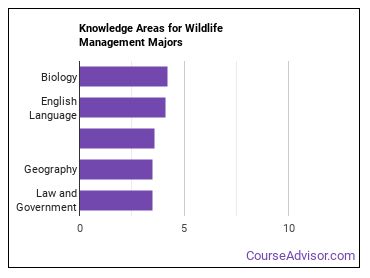
- Biology - Knowledge of plant and animal organisms, their tissues, cells, functions, interdependencies, and interactions with each other and the environment.
- English Language - Knowledge of the structure and content of the English language including the meaning and spelling of words, rules of composition, and grammar.
- Customer and Personal Service - Knowledge of principles and processes for providing customer and personal services. This includes customer needs assessment, meeting quality standards for services, and evaluation of customer satisfaction.
- Geography - Knowledge of principles and methods for describing the features of land, sea, and air masses, including their physical characteristics, locations, interrelationships, and distribution of plant, animal, and human life.
- Law and Government - Knowledge of laws, legal codes, court procedures, precedents, government regulations, executive orders, agency rules, and the democratic political process.
Skills for Wildlife Majors
wildlife majors are found most commonly in careers in which the following skills are important:
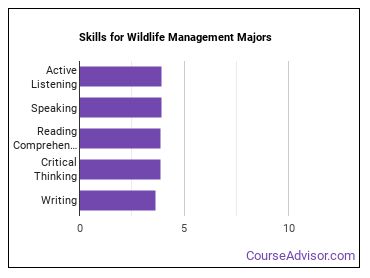
- Active Listening - Giving full attention to what other people are saying, taking time to understand the points being made, asking questions as appropriate, and not interrupting at inappropriate times.
- Speaking - Talking to others to convey information effectively.
- Reading Comprehension - Understanding written sentences and paragraphs in work related documents.
- Critical Thinking - Using logic and reasoning to identify the strengths and weaknesses of alternative solutions, conclusions or approaches to problems.
- Writing - Communicating effectively in writing as appropriate for the needs of the audience.
Abilities for Wildlife Majors
A major in wildlife will prepare for your careers in which the following abilities are important:
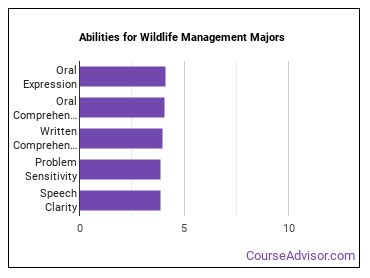
- Oral Expression - The ability to communicate information and ideas in speaking so others will understand.
- Oral Comprehension - The ability to listen to and understand information and ideas presented through spoken words and sentences.
- Written Comprehension - The ability to read and understand information and ideas presented in writing.
- Problem Sensitivity - The ability to tell when something is wrong or is likely to go wrong. It does not involve solving the problem, only recognizing there is a problem.
- Speech Clarity - The ability to speak clearly so others can understand you.
What Can You Do With a Wildlife Major?
People with a wildlife degree often go into the following careers:
| Job Title | Job Growth Rate | Median Salary |
|---|---|---|
| Fish and Game Wardens | 4.3% | $57,710 |
| Forestry & Conservation Science Professors | 4.5% | $86,900 |
| Park Naturalists | 6.3% | $61,310 |
| Range Managers | 6.3% | $61,310 |
| Soil and Water Conservationists | 6.3% | $61,310 |
| Zoologists and Wildlife Biologists | 7.7% | $63,420 |
Who Is Getting a Bachelor’s Degree in Wildlife?
Racial-Ethnic Diversity
At the countrywide level, the racial-ethnic distribution of wildlife majors is as follows:
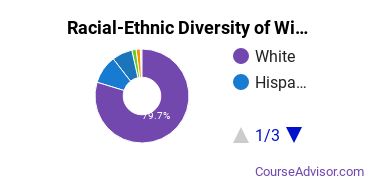
| Race/Ethnicity | Number of Grads |
|---|---|
| Asian | 38 |
| Black or African American | 22 |
| Hispanic or Latino | 175 |
| White | 1,319 |
| International Students | 3 |
| Other Races/Ethnicities | 109 |
Geographic Diversity
Wildlife appeals to people across the globe. About 0.2% of those with this major are international students.
Amount of Education Required for Careers Related to Wildlife
Some degrees associated with wildlife may require an advanced degree, while others may not even require a bachelor’s in the field. Whatever the case may be, pursuing more education usually means that more career options will be available to you.
How much schooling do you really need to compete in today’s job market? People currently working in careers related to wildlife have obtained the following education levels.
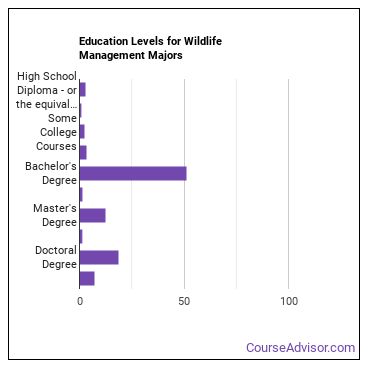
| Education Level | Percentage of Workers |
|---|---|
| High School Diploma - or the equivalent (for example, GED) | 2.7% |
| Post-Secondary Certificate - awarded for training completed after high school (for example, in agriculture or natural resources, computer services, personal or culinary services, engineering technologies, healthcare, construction trades, mechanic and repair technologies, or precision production) | 0.7% |
| Some College Courses | 2.4% |
| Associate’s Degree (or other 2-year degree) | 3.1% |
| Bachelor’s Degree | 51.2% |
| Post-Baccalaureate Certificate - awarded for completion of an organized program of study; designed for people who have completed a Baccalaureate degree but do not meet the requirements of academic degrees carrying the title of Master. | 1.2% |
| Master’s Degree | 12.5% |
| Post-Master’s Certificate - awarded for completion of an organized program of study; designed for people who have completed a Master’s degree but do not meet the requirements of academic degrees at the doctoral level. | 1.1% |
| Doctoral Degree | 18.6% |
| Post-Doctoral Training | 7.3% |
Online Wildlife Programs
The following table lists the number of programs by degree level, along with how many schools offered online courses in the field.
| Degree Level | Colleges Offering Programs | Colleges Offering Online Classes |
|---|---|---|
| Certificate (Less Than 1 Year) | 0 | 0 |
| Certificate (1-2 years) | 5 | 0 |
| Certificate (2-4 Years) | 0 | 0 |
| Associate’s Degree | 24 | 0 |
| Bachelor’s Degree | 5 | 2 |
| Post-Baccalaureate | 0 | 0 |
| Master’s Degree | 23 | 1 |
| Post-Master’s | 0 | 0 |
| Doctor’s Degree (Research) | 16 | 0 |
| Doctor’s Degree (Professional Practice) | 0 | 0 |
| Doctor’s Degree (Other) | 0 | 0 |
Explore Major by State
Alabama
California
District of Columbia
Idaho
Kansas
Maryland
Mississippi
Nevada
New York
Oklahoma
South Carolina
Utah
West Virginia
Alaska
Colorado
Florida
Illinois
Kentucky
Massachusetts
Missouri
New Hampshire
North Carolina
Oregon
South Dakota
Vermont
Wisconsin
Majors Related to Wildlife
You may also be interested in one of the following majors related to wildlife.
| Major | Number of Grads |
|---|---|
| Natural Resources Conservation | 23,672 |
| Natural Resource Management | 3,147 |
| Forestry | 2,243 |
| Fisheries Sciences | 505 |
| Natural Resources Conservation (Other) | 150 |
References
*The racial-ethnic minorities count is calculated by taking the total number of students and subtracting white students, international students, and students whose race/ethnicity was unknown. This number is then divided by the total number of students at the school to obtain the racial-ethnic minorities percentage.
- College Factual
- College Scorecard
- National Center for Education Statistics
- O*NET Online
- U.S. Bureau of Labor Statistics
- Usual Weekly Earnings of Wage and Salary Workers First Quarter 2020
- Image Credit: By Nicholas A. Tonelli under License
More about our data sources and methodologies.

